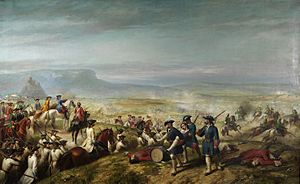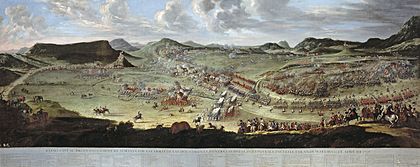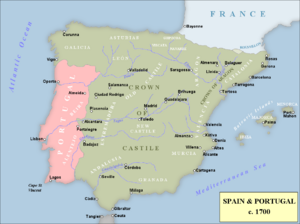Battle of Almansa facts for kids
Quick facts for kids Battle of Almansa |
|||||||
|---|---|---|---|---|---|---|---|
| Part of the War of the Spanish Succession | |||||||
 The Battle of Almansa by Ricardo Balaca |
|||||||
|
|||||||
| Belligerents | |||||||
| Commanders and leaders | |||||||
| Strength | |||||||
|
|
||||||
| Casualties and losses | |||||||
|
|
||||||
The Battle of Almansa happened on April 25, 1707. It was a major fight during the War of the Spanish Succession. The battle was between an army supporting Philip V of Spain and another supporting his rival, Archduke Charles of Austria. Philip V's side won a big victory. This win helped him take back most of eastern Spain.
The army fighting for Philip V was led by the Duke of Berwick. He was the son of James II of England. The forces supporting Archduke Charles were led by Henri de Massue, Earl of Galway. He was a French Huguenot who had left France. This battle is special because an English commander led the French side, and a French commander led the English side!
Contents
What was the War of the Spanish Succession?
The War of the Spanish Succession was a big European conflict. It lasted from 1701 to 1714. The war was fought to decide who would be the next king of Spain.
Who was fighting?
One side supported Philip V of Spain. He was from the Bourbon family, which also ruled France. So, France and Spain were allies.
The other side supported Archduke Charles of Austria. He was from the Habsburg family. His allies included England, Portugal, the Dutch Republic, and the Holy Roman Empire. This group was called the Grand Alliance.
Why was Spain important?
Spain was a very powerful country at the time. It controlled a huge empire around the world. Everyone wanted their chosen person to rule Spain. This would give them more power in Europe.
Before the Battle
Fighting in Spain was difficult. It was hard to move supplies and food for large armies. This was because of the dry land and lack of good roads. Most supplies had to travel by water.
The Grand Alliance got a base in Lisbon, Portugal, in 1703. This happened when Peter II of Portugal switched sides. In 1704, Archduke Charles arrived to lead the land war.
Early Battles and Changes
The French and Spanish armies won some smaller battles. But the British captured Gibraltar, a very important port. Attempts to get Gibraltar back failed.
In 1705, the English made a deal with people in Catalonia, Spain. This opened a new fighting area in the northeast. The Allies captured Barcelona and Valencia. This left only one major port for the French and Spanish in the western Mediterranean.
In 1706, Philip V tried to take back Barcelona, but he failed. While he was away, the Allies captured Madrid. But they couldn't get enough supplies there. So, they had to leave Madrid.
By late 1706, Philip V still controlled most of central and southern Spain. The Allies had won big victories in other parts of Europe. So, the Earl of Galway decided to attack Spain again in 1707.
Setting the Stage for Almansa
To stop Galway, the Duke of Berwick became the commander of the French and Spanish forces. He had about 33,000 soldiers. These were half French and half Spanish. Some Irish soldiers who had left Ireland also joined them.
Before attacking Valencia, Berwick sent 8,000 men to attack Xàtiva. This made the Allied commander, the Earl of Peterborough, keep his troops in Catalonia. He didn't join forces with Galway and Minas. This meant Galway and Minas had fewer soldiers.
On April 22, Berwick stopped his army near Almansa. From there, he could threaten the Allied supply lines in Valencia.
The Battle of Almansa

The Allied army started marching early on April 25. They reached Almansa after a long and tiring walk. The Duke of Berwick had already set up his army. His soldiers were in two lines in front of the town. The foot soldiers were in the middle. The French and Spanish cavalry (soldiers on horseback) were on the sides.
Even though Galway had fewer soldiers, he attacked in the afternoon. First, there was a short exchange of cannon fire. Galway's foot soldiers pushed back the French and Spanish center. But a gap appeared between them and the Portuguese soldiers on the right. The Portuguese were led by the 63-year-old Marquess of Minas.
Seeing this gap, the French and Spanish cavalry attacked. The Duke of Berwick said the Portuguese fought bravely. But they eventually broke and ran away. A few groups of soldiers, led by Minas himself, covered their retreat. Minas's mistress, who fought dressed as a man, was killed during this.
The Allied center was now being attacked from three sides. Galway used his remaining cavalry to help some of his troops escape. But 13 groups of soldiers got separated from the main army. The Spanish cavalry chased them. These soldiers tried to defend themselves about 8 miles from the battle. But they had to surrender the next morning.
Historians have different numbers for how many soldiers were lost. One estimate says the Allies lost about 4,000 killed or wounded and 3,000 captured. The French and Spanish lost around 5,000 killed or wounded. Other estimates say the Allies lost up to 17,000 soldiers, including those captured. The French and Spanish losses were much smaller, around 1,500 to 2,000.
After the Battle
Almansa was a very important battle in the war. Many people admired the Duke of Berwick's tactics. Frederick the Great, a famous king and general, later called it the most impressive battle of the century.
The victory meant Philip V now controlled most of northeastern Spain and Valencia. By the end of 1707, the Allies were mostly limited to Catalonia and the Balearic Islands.
What happened next?
The French and Spanish army continued their success. They attacked Xàtiva. When the town surrendered in June, much of it was destroyed. Its name was even changed to 'San Felipe.' Today, in memory of these events, a picture of the king still hangs upside down in the local museum.
The defeat at Almansa had a big impact on Valencia and Catalonia. It led to two modern sayings:
- "De ponent, ni vent ni gent," which means 'From the west, neither wind nor people.'
- Quan el mal ve d'Almansa, a tots alcança, which means 'Bad news from Almansa reaches everybody.'

See also
 In Spanish: Batalla de Almansa para niños
In Spanish: Batalla de Almansa para niños
- Battle of Almansa reenactment


